 In the second part of the performance-fexibility series (introductory article, second article about foam rolling), we talk yoga: its many benefits, common running-specific poses and sequences, and how it fits into an ultrarunner’s training routine.
In the second part of the performance-fexibility series (introductory article, second article about foam rolling), we talk yoga: its many benefits, common running-specific poses and sequences, and how it fits into an ultrarunner’s training routine.
Yoga is an ancient physical and mental practice that remains popular today for its balance of strength, range of motion, and relaxation. Although it can intimidate some, yoga is gaining traction in the running community for its ability to improve mobility.
More than stretching, or even core stability, a quality yoga practice provides four vital components of efficient running:
- Spinal mobility. Yoga emphasizes spinal mobility through whole-body motions, alternating between flexion, extension, side-bending, and rotation.
- Nervous-system mobility. On top of spinal motion, yoga creates nerve mobility by adding arm and leg motions, often in functional positions emphasizing spinal neutral, just like running.
- Breath control. A fundamental concept of yoga is breathing. Breath control, or pranayama, involves disciplined breathing through the nose, only. For a full practice, yogis breathe deeply through the nose, expanding the entire ribcage and abdomen, sequencing breathing through shifting poses. Optimal breathing has numerous benefits: increased oxygen update, improved pain and discomfort tolerance, relaxation, and stress reduction.
- Pattern replication. Emphasizing spinal neutral, hip mobility, and pelvic stability, yoga poses and sequences closely mimic the natural, efficient running stride pattern.
So, besides simply stretching, a yoga practice works on the same patterns and principles of efficient running.
Types of Yoga
There are many types of yoga practices, ranging from slow movements emphasizing prolonged holds in deep positions, to fast-paced, energetic, strength- and fitness-based practices.
Runners new or experienced with yoga would benefit from a balanced, middle-of-the-road vinyasa flow practice, which involves a moderate-paced sequence of yoga poses, interconnected through arms, legs, trunk and breath. The cornerstone of this type of practice is the vinyasa flow. This is a yoga sequence which involves finding your way into a a yoga plank–or a straight-arm, push-up position:

Next you lower down, briefly hovering over the floor. This is called chaturanga:
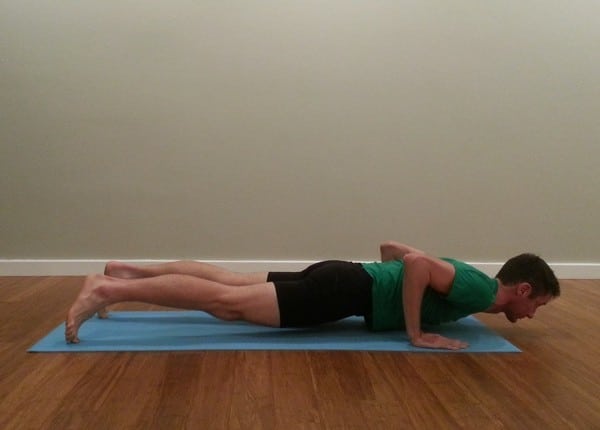
From there, yogis transition into a spinal-extended position called upward-facing dog:
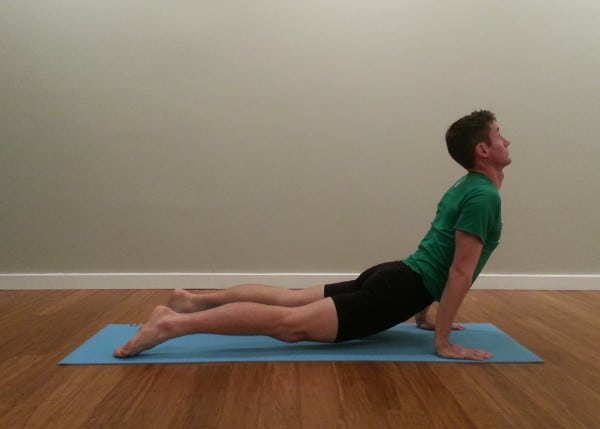
This is a critical motion in a runner yogi’s practice. A well executed upward dog should include traction: the toes are anchored down, while the arms pull the body forward and away from the feet as you arch upward. This creates a traction effect, which opens space between vertebrae, creating a maximal, balanced back stretch.
After holding the upward dog for a breath, the vinyasa finishes by transitioning into downward-facing dog. This position emphasizes straight (as possible) legs on a neutral (as possible) trunk:
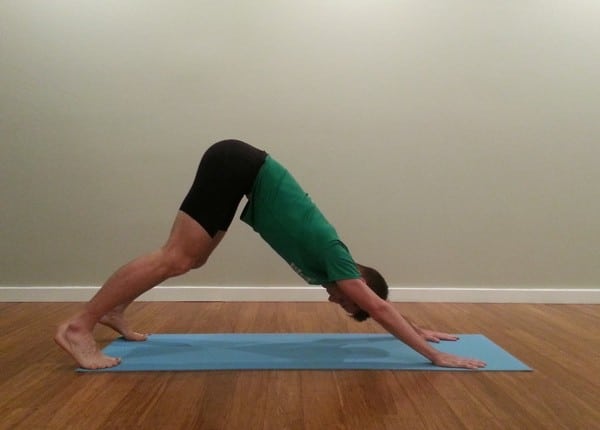
The vinyasa sequence is the core of a vinyasa-type practice. It may be repeated upwards of 30 times in an hour-long practice, providing ample opportunity to stretch both the spine and leg muscles and nerves.
From there, there are several other helpful poses, emphasizing running-specific hip action:

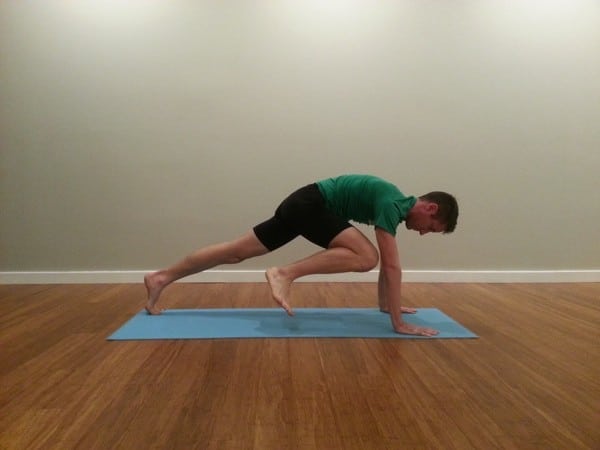
There are several poses that emphasize trunk and pelvic mobility, which is crucial for running efficiency, but frequently stiffened with long runs or heavy mileage:

The side-angle pose represents a great example of a pose that promotes both flexibility–of the trunk, pelvis, and arms–as well as strength, as the hips and shoulders must work hard to hold this position.
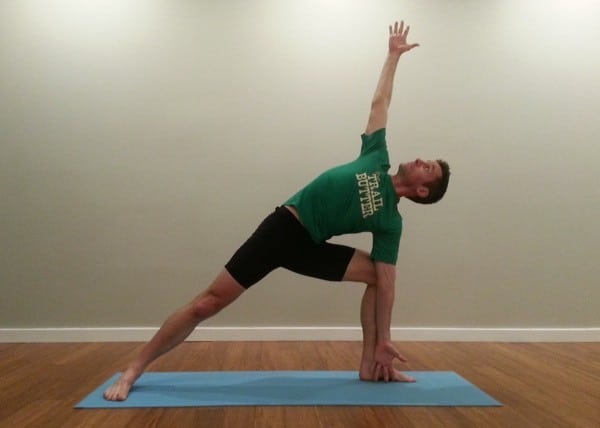
Then, of course, if you ever get tired, a child’s pose is a great way to regain breath control, as well as get a flexion stretch–also aided by traction from the arms, which are anchored in front:
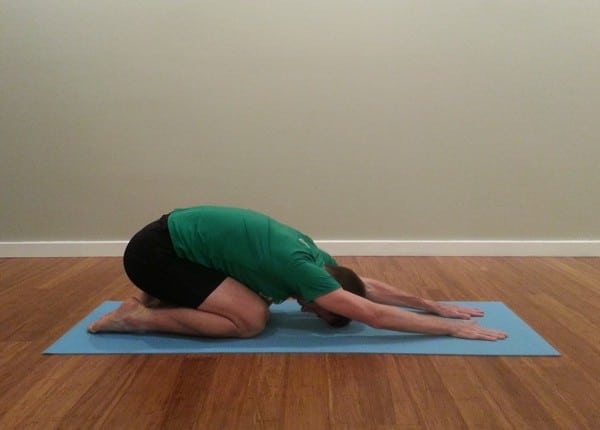
During an hour-long, balanced, vinyasa flow class, you might engage in strenuous poses and flow sequences for roughly half of that time. Other components of the yoga practice include:
- Back-bends. The bridge pose the classic back bend, which promotes hip and back strength.
- Inversions. Examples include shoulder stands, headstands, and even handstands.
- Passive, prolonged stretches. These more conventional stretches typically target the trunk, hips, and hamstrings that most runners are accustomed to stretching. These stretches are much more effective at the end of a progressive yoga practice, as the body is warm and the tissues are more mobile, but not significantly fatigued.
Q&A with a Runner Yogi
My own yoga practice began three years ago, just a week after the 2012 Western States 100. I was extremely stiff and sore, and looking for an activity to get me moving, yet still be restful. Yoga fit that bill, perfectly, and the more I explored yoga, the more I realized the similarities and benefits to running.
Recently, I’ve been practicing at Mudra Yoga, a Eugene, Oregon studio that caters to a variety of different backgrounds and interests. I find their classes and instruction to be a perfect balance for runner’s needs. Studio owner and lead instructor Heather Nelson is a runner herself and she tailors many of her classes toward the local running community. I asked her a few questions about yoga and running:
iRunFar: Why should runners engage in a yoga practice?
Heather Nelson: Everyone can benefit from a yoga practice and especially those with strong, repetitive patterns like runners. As a former runner, I realize how strong running can make a person. (And don’t even get me started on that fabulous runner’s high!) However, when I incorporated yoga into my life, I was struck by my lack of flexibility and joint range. The strength developed when running is a wonderful thing, yet the muscles are constantly worked within a specific range and major joints are impacted continuously. Yoga counters these repetitive habits by exploring full ranges of motion in the joints, rectifying muscle imbalances, and heightening body awareness.
iRunFar: What are the physical benefits of yoga that compliment competitive running?
Nelson: Let’s face it, training for races can be hard on the body. The repetition, the striving, the pushing through fatigue – it all can lead to skeletal, muscular, and connective tissue strain or failure. Through strengthening underused muscles, releasing excessive tension, developing full body awareness, and establishing balance, a steady yoga practice has the power to prevent injuries. Yoga builds better posture, body awareness and mobility. With these tools runners become more efficient in their strides.
iRunFar: What benefits–outside of mobility and strength–might runners get from a yoga practice?
Nelson: I’m so glad you asked this question! Yoga is more than muscles and tendons: it unifies body, mind, and spirit. Yoga calms the nervous system, focuses the mind, and gives practitioners the time out needed to reflect on and direct their intentions. Yoga also gives you space to let go of your competitive nature for a time. On the mat there need not be judgment, over-striving, or disappointment.
The breath work, or pranayama, used in yoga is also an amazing compliment to running. Through controlled breathing you not only to focus the mind but also maintain a sustainable rhythm. This is an amazing tool to have in your back pocket when considering pacing.
Through yoga the nervous system and mind are also trained to stay calm and resilient, allowing you the ability to mellow out at the beginning of a race, more effectively drive up the steep hill, push through the doldrums of the middle miles, and kick it in at the finish line.
If practicing in a studio, you get additional benefits like learning proper alignment through a qualified instructor, and becoming part of a community happy to cheer you on through your next running adventures.
iRunFar: What types of yoga would be most helpful for runners?
Nelson: Any balanced yoga practice is designed to safely work into all areas of the body: one that touches into multiple give-and-take, strengthen-and-release postures that affect a range-of-body areas. If you are new to yoga, start with a slower class that instructs proper alignment. When I started yoga as a runner, a vinyasa-flow practice was a natural fit as it aligns breath with movement and feels rhythmic like running. This cardiovascular and creative style keeps one firmly rooted in the body and out of the mind by mixing up postures and transitions that simply require the mind to stay along for the ride.
Faster styles of vinyasa are perfect in lieu of a training day. Slower-paced vinyasa compliments mellow run days. If you are training hard and have weary muscles or soreness, restorative yoga is a dream. It combines gentle movement with supported, long-held postures that assist one in releasing physical tension, easing the muscles, and bringing on a more meditative state–taking this class is like pushing a body/mind reset button.
iRunFar: What’s the optimal frequency for runners to benefit from yoga practice?
Nelson: Three to five times a week is a ideal target range. Runner’s develop tightness every time they run–I was always amazed by how one of my first instructors could tell when I had been running and not practicing yoga. Now that I teach, I see it in my students too. Those that come in to practice at least three times a week maintain a great level of mobility. In addition to a regular yoga practice, incorporating just a few poses or sun salutes along with your regular stretches will have your body thanking you!
***
Frequent yoga practice is a commitment, but a once-a-week routine is a great start for any runner. Beyond that, most will find that a yoga practice in lieu of a recovery run to be more beneficial than more base mileage, making it more feasible to fit into busy training schedule. Finding a local studio nearby work or home is also helpful, and most studios have classes in the morning, noon, and evening hours.
Maintaining mobility is difficult, and for many runners, improving it may seem impossible. But a consistent yoga practice can do just that, as well as improve overall strength, breathing, and stress management–all vital components to better aerobic fitness.
Train smarter, not harder. Yoga can be an integral part of that philosophy, and bring your running and your life greater joy and success.
Call for Comments (from Meghan)
- Do you practice yoga? If so, what are the benefits you experience?
- What kinds of yoga do you practice? How do those specific kinds of yoga help your practice?
- What specific yoga poses do you think help you and your body’s running-induced tensions the most?
